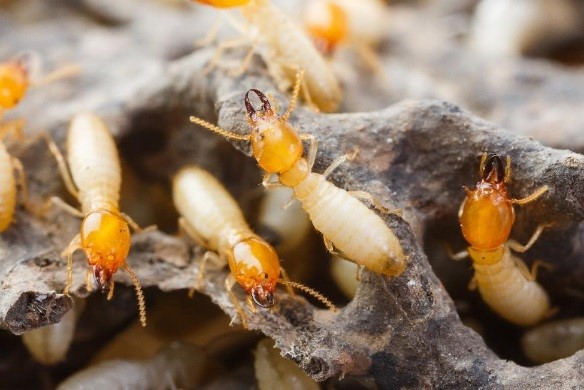Soy Beans
Pests and Diseases
 Caterpillars: soybean lopper, leaf miners, leaf rollers
Caterpillars: soybean lopper, leaf miners, leaf rollers
- These insect pests feed on the foliage
- They reduce the plant photosynthetic area thereby affecting final yield
- Once insecticide application is usually enough to control insect attacks
- can also be controlled by applying Tephrosia Vogelii (Fish bean) seeds and leaves which are a good local insecticide
Termite
- Can attack soybean plants at any stage of development from seed to mature soybean plant particularly when there is prolonged dry spell
- First sign of termite attack is wilting leading to death or falling over of plants
- Pull out affected plants to examine roots and lower stem for live termites and/or tunneling
- Plant roots and stems may be completely hollowed out and soil-filled
- Damage by termites is greater in rain-fed than irrigated crop, dry periods than periods of regular rainfall, lowland rather than highland areas, and in plants under stress rather than in healthy and vigorous plants
- Plants can be under stress from weeds competing with crops for nutrients, light and water, hence increasing susceptibility to termite attack.
- Crop rotation and removal of other debris from the field reduces build-up of termites, reduces potential termite food supplies, thus reducing termite number and subsequent attack
Pod-sucking buds - Attack crop from flowering onwards
- Insect pests can be controlled with a single spray of Cypermethrin + Dimethoate 10 EC. Read the chemical label for instructions.
 Soybean Rust
Soybean Rust
- The only disease of economic importance
- Other diseases such as frogeye, bacterial pastule, red lead blotch occur but are less important economically
- Asian soybean rust, caused by Phakapsora pachyrhizi, is one of the notable foliar soybean diseases in Malawi
- Infected leaves have small tan to dark brown or reddish-brown lesions on which small raised pustules (or bumps) occur on the lower surface of the leaves
- Pustules produce a large number of spores
- Brown or rust-colored powder falls when severely infected leaves are tapped over a white paper or cloth
- Severe infection leads to premature defoliation and yield losses up to 80%
- Soybean rust is of great economic importance where humidity and rainfall are high
- Late planted soybean is prone to soybean rust infection
Soybean cyst nematode (SCN), Heterodera glycines
- It can be present in the field without causing obvious above-ground symptoms
- In heavily infested fields, SCN can cause yield losses of more than 30%
- “yellow dwarf” describes the symptoms that are commonly caused by SCN
- Infested plants become stunted, canopy closure does not occur, leaves become chlorotic; however, these symptoms may also be caused by other crop stresses such as nutrient deficiencies
- Severely infected plants may die before flowering, especially during dry periods where soils have poor water holding capacity
Control of SCN:
- Ensure good soil fertility and adequate moisture increase tolerance and reduce the severity of above-ground symptoms in fields
- Employ good crop production practices to reduce severity of nematode infestation; for instance, a 1 to 2-year rotation with Maize or cotton (non-hosts) has proven effective for many soybean growers
- Use resistant varieties such as Ocepara 4
Virus diseases:
- Commonly transmitted by insects such as whitefly
- Symptoms range from mosaic and mottling, leaf curling, green vein banding, and stunting
- Soybean is also susceptible to several viruses transmitted by aphids and beetles prevailing in Malawi
- Foliar symptoms of virus infection include mosaic and mottling, thickening or brittling of older leaves, puckering, leaf distortion, severe reduction in leaf size, and stunting of plants
- Remove and burn infected plants
 6.1 General Control of Soybean diseases:
6.1 General Control of Soybean diseases:
- Use certified seed to avoid seed-borne infection
- Use varieties resistant to prevailing diseases of the area
- Plant early to escape diseases that come late in the season and to encourage good establishment of soybean plant to withstand disease attack
- Avoid planting seeds obtained from mosaic affected plants
- Uproot and destroy symptomatic plants
- Do not use seed that is cracked or broken; take care during harvesting and handling to reduce mechanical damage
- Rotate soybeans with non-host crops such as Maize or sorghum
- Eradicate weeds and voluntary plants in the vicinity of soybeans sites as weeds act as these act as host agents.
